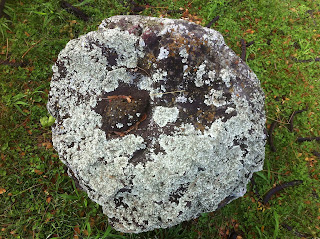McAllister lists only two unnamed heiau in his archaeology of Oahu. Told to him by his informant of that area, Pahu. The first is in the vicinity of 2290 Liliha St...
At the location given. I found a hill which in the old times would have protruded higher then the rest of the valley floor. In the nearby area. Between two properties. As there is no actual 2290 Liliha St address. The bordering properties on either side of the hill top have very large pohaku decorating their garden. Some even built into their perimeter walls.
I tried to see if anyone was home to talk to and ask my all too frequent question about mo'olelo, but no one was there to answer on both properties.
Here a coral stone sits amongst a Japanese style garden. Full of significant stones that may have been a part of the heiau.
The second unnamed heiau location given by McAllister's informant, Kapena. Is on 2712 Nuuanu Ave.
A story follows that a man from "the coast" came to Honolulu to build a home. He chose the location of the heiau sited here. Against the warnings of local Hawaiians, he began to plow up the site. While his home was being built, he travelled back to the States to invite his fiancé. His engagement was somehow broken and he returned to Honolulu alone. Then died of tuberculosis in less than a year of living in his home. The house was sold to new owners and burned down after only three weeks.
My visit here also came up empty, with no one being around to answer questions.
Just before you enter Oahu Country Club. The second to the last house on the right has a long driveway that leads to the Pohaku a'umeume. It can also be seen from the Oahu Country Club service road, through the fence. Pohaku a'umeume marks the eastern boundary of the OCC property. A fee simple title was given to T.C.B. Rooke for "services rendered", the district of Waolani. Waolani is a separate valley inside of the ahupuaa of Nuuanu. A separate peak, Nuumealani jutting out from the western ridge of Nuuanu, into almost half of Nuuanu valley. Separates Waolani and another land area known as Puiwa.
Further into the OCC property in the back of Waolani. Are said to have been four Heiau. One of which being Kawaluna Heiau. A very important heiau to the early high chiefs of Oahu. I will delve deeper into that famous heiau another day. Where legendary ali'i dwelled, battled, and later cared for the sick and lame. Until the overthrow of other Ali'i of the island. If only I can visit that secret, private land in person. Wakea is said to have lived on the ridge of Waolani when he first arrived on the island. Also Kane and Kanaloa visited this area in creation legends.
Pohaku a'umeume was the center of a mythical battle between the Menehune king, Ahipuu and a giant king. The stone was tossed back and forth until it finally struck the giant king in the head. Ending the battle and being left by the menehune. Where it can now be found. The numerous indentions on the stone are supposed to be the hand prints of both the giant king and the menehune.
Another story goes that menehune themselves tugged at both sides of the stone. One side, the Namu and the other side, the Nawa. Over the position of the stone in the valley. Some wanted it mauka and some makai. The Waolani side won.
The Pohaku a'umeume means "the stone of contention." Where descendants of Oahu's king Kakuhihewa could be truly detected. If a claimed ume ume practitioner of the Kakuhihewa line could not move the stone. His recollection of his lineage was said to be false. The women descendants would come to have their umbilical cord cut on the stone. Most likely after child birth at a birthing stone. In what is now Queen Emma's Summer Palace garden nearby. If the fathers line, that was not of Kakuhihewa wanted to name the child at a disagreement to the mother. A kahuna would come and the parents would resolve the argument by trying to move the stone. If no winner was chosen. The Kahuna could then receive a suggested name from the stone itself.
Here, behind or nearby what is now the Tenrikyo Mission Headquarters. I found these two gigantic stones. The Ahipuu St. area was the location of a fort of the Kona warriors. In defense of raids from the Ko'olau warriors. Ahipuu, the hill of fire. Was the location of Haipu. A beacon of fire would be lit here. If warriors from the other side of the island were spotted gathering on the mountain tops readying an attack. Stationed warriors already at Haipu would be joined by reinforcements on the Kona side. To make war on the warriors of the Koolau district.
Behind the Consulate General of Korea property. Are remnants of what looks to be a lo'i. Kamakau noted garden patches on either side of the road grew taro, potatoes, bananas, awa, wauke, suger cane,and olona to name a few.
Here is a house or church ruin in Maemae Cemetery. I have contacted Kaumakapili Church, the caretakers of this and the Pahoa Cemetery. For more information about those entered there and about the structure found here, I await a reply. The church is also named after a famous pohaku in Nuuanu Valley that is associated with menehune legends.





















































